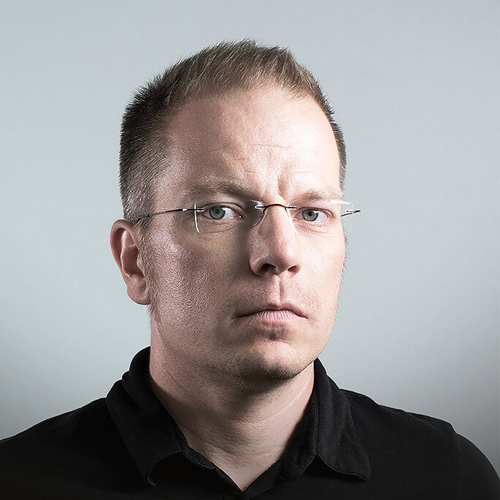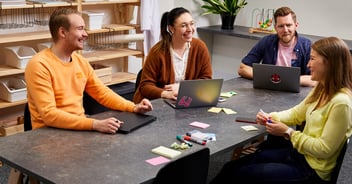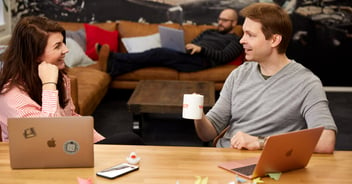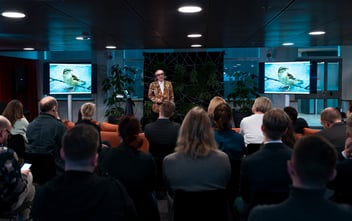Creative thinking, design communication to stakeholders and design critique are skills that anyone who works with problem-solving can practice. We worked on these topics with my mentor in Vincit’s mentoring program, and I’ll be sharing my thoughts in this blog series.
Vincit’s mentoring program offers an interesting perspective on and a goal-oriented method for personal development. It’s a way to complement other learning and to draw from the immense competence development potential within our professional community, which for me was one of the main motivators for joining Vincit. I’ve participated in our mentoring program as both a mentor and as a mentee; this blog is written from the latter perspective.
Vincit’s mentoring program
Vincit’s mentoring One of my core beliefs is that my field of work requires me to constantly develop my skills and thinking in order to be professionally relevant to my employer, clients and colleagues. This is why it was self-evident for me to hop on the mentoring program when the opportunity showed up.
At the beginning of the program, the mentee and the mentor collectively figure out the goals for the process. My goals felt quite clear from the very beginning, and I found it easy to verbalize them. In my role as a designer, I’ve always had plenty of independence and autonomy. Before I joined Vincit, I didn’t have a large and close-knit design community around me that would help me reflect on my work. I also believe that a designer must be able to observe their work analytically and critically and to abandon even the most precious ideas and solutions when faced with facts. Based on this, I formulated my design goals as follows:
- Developing my conscious analyticism and design critique. From intuition to justified decisions…
- … so that others are on board, i.e. developing my skills of transparency and verbalizing my work.
- From analyticism towards unlimited optimism and creative thinking.
The spring of 2020 was, of course, a challenging time for kicking off a mentoring process. However, together with my mentor Kimmo Tuomainen we managed to get together for regular sessions where we discussed design work and project examples around my goals.
At the end of the year, I decided to continue working on my goals with the help of a learning journal. I promised myself to continue this experiment for three months, so every week I wrote down my experiences with the help of these perceptual cycle questions:
- What did I do, say, hear or see?
- What emotions did it evoke?
- What thoughts or ideas stemmed from it?
- On this basis, what are my next steps?
At the end of my mentoring process, we summarized the key learnings from my journal entries and discussed how to continue working towards my goals within my current client project. The learning journal experiment felt so good that I decided to carry on with it until my summer vacation. Kimmo and I finished the mentoring process at the end of May. Even though the actual program ended, I still continue to work on my goals with practical exercises whenever a good opportunity comes along.
In the following chapters and articles, I’ll be going through the insights that arose from my mentoring process and my learning journal. I believe that these notions will offer food for thought for those who work in different creative problem solving roles as well.
Creative thinking
I used to think that in order to be successful, designers need to be creative in the sense that new ideas simply keep popping up left, right and center – all you need to do is think. I’ve never felt creative, at least not in that way. Also, throughout my professional career I’ve always been more interested in how we do things instead of what we do. Later on, I’ve learned different ways to feed my creativity and produce ideas.
And yet, I’m fascinated by the thought of pulling ideas out of a hat. How could one develop that skill? One way, of course, is to be interested in the world in general, follow current phenomena and trends and hand-pick things to apply in similar or completely new contexts. Derivative of this, benchmarking or finding comparisons from similar and different fields and contexts, competitor analyses or comparative usability testing can help expand your thinking and turn it away from the obvious tracks towards something new. The wider the multi-disciplinary group that performs this information gathering and analysis, the more it fuels the project to discover new suitable solutions. Quick concept design and the outlining of parallel solution options supports, clarifies and directs the conclusions of information gathering (more on this later). At this point, it’s good to paint the concept with a wide brush in order to leave room for growth, iteration, new directions and ideas, or even pivoting the whole business model.
Observe, iterate, create coherence
How much, at what stages and how often should one do this exercise? It depends on the project. Agile development projects offer opportunities and demand regular examining and re-examining, especially if the goal and vision of the project are yet not set in stone.
But what to do when, for the fifth time, you’re trying to figure out whether the data on a database table should be displayed as a list, spreadsheet, on a separate screen or in a modal dialog? Even if there is no design system in the project, it’s likely that some kind of a model for presenting information has taken shape as a result of previous reflections. Should you still get inspired to find a new angle from the outside world, or simply copy the contents of your previous JIRA ticket as a template?
In these situations you tend to lean towards a solution that is coherent and similar to your previous solutions. Especially with larger-scale projects, developing a coherent UI takes daily observation, and it is the designer’s job to act as coherence police for both their own solutions and others’. Users appreciate solutions that function predictably and logically. It is of course possible to work on coherence with blinders on, at the expense of usability. As it happens, for a designer everyday creativity often means justifiably departing from rules on the grounds of intuition or facts.
One observation from the era of remote working is that spontaneous ideation and concept sketching at a whiteboard are no longer a part of our everyday routines. Earlier, many an idea got sketched and refined in the same amount of time that it now takes to put together a meeting invite for sometime next week. Yes, you can still sketch, talk and challenge together, but it takes more effort to do it remotely. Oftentimes the whiteboard is a superior tool, and on-screen communication isn’t as effective as face-to-face interaction.
Continuous learning
In a self-steering organization, everyone has the power and the responsibility to develop their own competencies. In addition to mentoring, Vincit’s Univincity offers many ways for competence development. A creative combination of study groups, trainings and coaching sessions as well as competence-enhancing working methods within client projects make sure that everyone finds suitable ways for continuous learning.
However, it’s not always simple to utilize your working community’s competence potential for personal development. Often it’s about whether your current client project supports your learning goals and whether you can adapt your everyday project work to support your goals better. Another essential question is whether you have enough time and energy within your workweek to pursue your goals consistently. When everything falls into place, your work can rise to completely new heights and reach new levels in a very short amount of time.
This is our first article of the "How to boost design thinking" blog series. You can find the next articles here:



